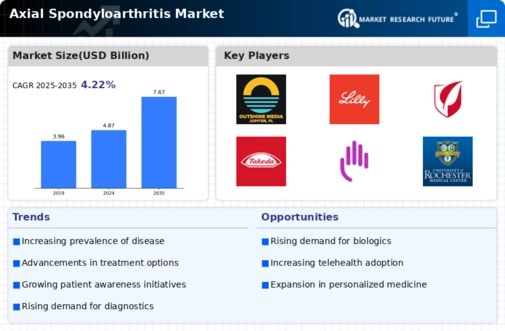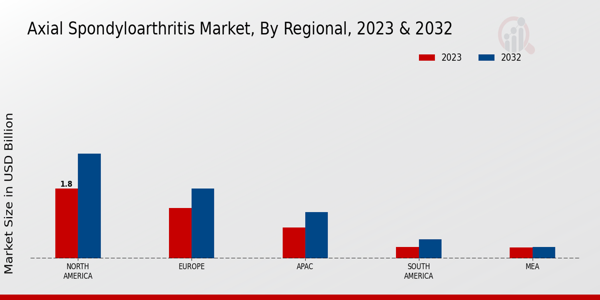Market Growth Projections
The Global Axial Spondyloarthritis Market Industry is poised for substantial growth, with projections indicating a market value of 4.87 USD Billion in 2024 and an expected increase to 7.67 USD Billion by 2035. This growth reflects a compound annual growth rate of 4.22% from 2025 to 2035. Such projections suggest a robust demand for treatment options and healthcare services tailored to axial spondyloarthritis. The anticipated growth is influenced by various factors, including advancements in treatment, increasing prevalence, and rising healthcare expenditures. These projections highlight the market's potential and the importance of ongoing research and development in this field.
Growing Awareness and Education
Enhanced awareness and education regarding axial spondyloarthritis among healthcare professionals and the general public are driving the Global Axial Spondyloarthritis Market Industry. Campaigns aimed at increasing knowledge about the disease's symptoms, early diagnosis, and treatment options are crucial. As more individuals recognize the importance of seeking medical advice, earlier interventions can be made, potentially improving patient outcomes. This growing awareness is likely to lead to increased diagnosis rates and, consequently, a higher demand for treatment options. The market's growth trajectory is supported by these educational initiatives, which aim to empower patients and healthcare providers alike.
Increasing Healthcare Expenditure
The rise in global healthcare expenditure is a crucial factor impacting the Global Axial Spondyloarthritis Market Industry. Governments and private sectors are investing more in healthcare infrastructure, which includes the development of specialized services for chronic conditions like axial spondyloarthritis. This increase in funding facilitates better access to diagnostics, treatment, and ongoing patient care. As healthcare systems evolve to accommodate the needs of patients, the market is likely to experience sustained growth. The anticipated compound annual growth rate of 4.22% from 2025 to 2035 reflects the positive trajectory of healthcare investments in managing chronic diseases.
Advancements in Treatment Modalities
Innovations in treatment modalities for axial spondyloarthritis are significantly influencing the Global Axial Spondyloarthritis Market Industry. The introduction of biologic therapies and targeted treatments has transformed patient outcomes, offering more effective management of symptoms and disease progression. These advancements not only improve the quality of life for patients but also drive demand within the market. As new therapies receive regulatory approval and become available, the market is expected to grow, with a projected value of 7.67 USD Billion by 2035. This trend indicates a robust pipeline of therapeutic options that could reshape treatment paradigms.
Emerging Markets and Demographic Shifts
Emerging markets, particularly in Asia and Latin America, present new opportunities for growth in the Global Axial Spondyloarthritis Market Industry. As these regions undergo demographic shifts, including urbanization and an aging population, the incidence of chronic diseases like axial spondyloarthritis is expected to rise. Increased access to healthcare services and evolving economic conditions in these areas will likely enhance the demand for effective treatment options. This trend indicates a potential expansion of the market as healthcare systems adapt to meet the needs of growing populations. The evolving landscape in these regions could significantly contribute to the overall market growth.
Rising Prevalence of Axial Spondyloarthritis
The increasing prevalence of axial spondyloarthritis globally is a primary driver of the Global Axial Spondyloarthritis Market Industry. Current estimates suggest that approximately 0.5% to 1% of the global population is affected by this condition, with higher rates observed in certain regions. This growing patient population necessitates enhanced healthcare services and treatment options, thereby propelling market growth. As awareness and diagnosis improve, more individuals are likely to seek medical attention, further expanding the market. The projected market value of 4.87 USD Billion in 2024 underscores the urgency of addressing this rising health concern.
















